Changing the water in the aquarium

Many people like the presence of pets, but not every apartment can have a cat or a dog, and not everyone can withstand this for health reasons. The most comfortable animals that can be kept at home, spending a little time on care and attention are aquarium fish. The variety of sizes, colors and characteristics of these pets attracts the attention of both adults and children. In order for the fish to live a long time and give life to a new generation, it is necessary to be able to properly care for them and change the water in the aquarium in time.
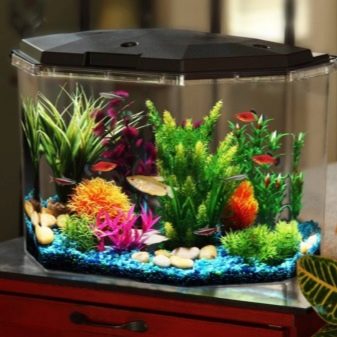
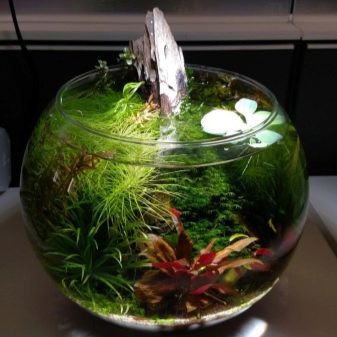
Types of water replacement
Water is the main habitat for fish, therefore its quality, purity and chemical properties play an important role. In nature, the aquatic environment renews itself, doing it gradually, without creating discomfort for its inhabitants. Ideally, aquarium fish need the same conditions and can be created if desired. There are several ways to change the water in the aquarium:
- by completely replacing content;
- due to the replacement of a small amount of moisture with a new one.
Each of the methods has its own advantages and disadvantages, therefore the choice must be made consciously, otherwise you can harm the fish.
In a new aquarium, which is bought for existing fish, usually there is no water, and it is worthwhile to fill it with thoroughly wash the inside of the container, cleaning it from dirt and dust that had accumulated there earlier. For surface treatment, it is important not to use strong detergents, the residues of which can linger inside and dissolve in the water, negatively affecting the health of aquarium fish.
If you are buying an aquarium with water, plants and fish, then first of all it is worth asking the seller about when it is worth making a change, and how best to do it.
A qualified specialist will clearly explain all the nuances, and new pets will get used to the new environment much faster. If the seller does not have such extensive knowledge, then it is necessary to independently decide on the type of water change and the time for this procedure.
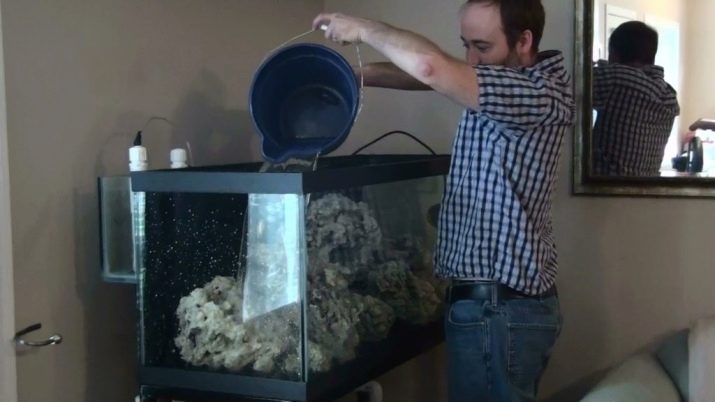
Partial
A partial change of water for aquarium fish is a necessity, as waste from the life of fish, plants and other inhabitants gradually begins to accumulate, which interferes with their normal functioning. With a large aquarium and a modest number of fish and plants at your disposal, as well as using good cleaning filters, you can leave the water untouched for quite a long time without making any changes. If a dozen or more fish live in the aquarium, then it is important to update the aquatic environment from time to time and monitor the cleanliness of the contents of the aquarium.
Any natural bodies of water where fish live, necessarily have currents, which bring in new water, circulating the streams. If this does not happen, then the process of formation of harmful microorganisms begins, and all living things gradually die off due to an increase in the level of toxins and nitrates. If you make a partial fluid change, you can reduce the amount of harmful components, which will have a beneficial effect on all the inhabitants of the aquarium, otherwise the fish will start to die out.
The concerns of aquarium fish industry professionals about water changes stem from the fact that after this procedure, the microclimate and ecological balance change, even if only one fifth is replaced. Positive in this case will be the rapid rate of restoration of a normal environment and a comfortable well-being of all the inhabitants of the aquarium.
If half of the aquatic environment is replaced at once, then at least two weeks will be spent on the resumption of normal conditions, and the fish can poorly endure this period, even die.
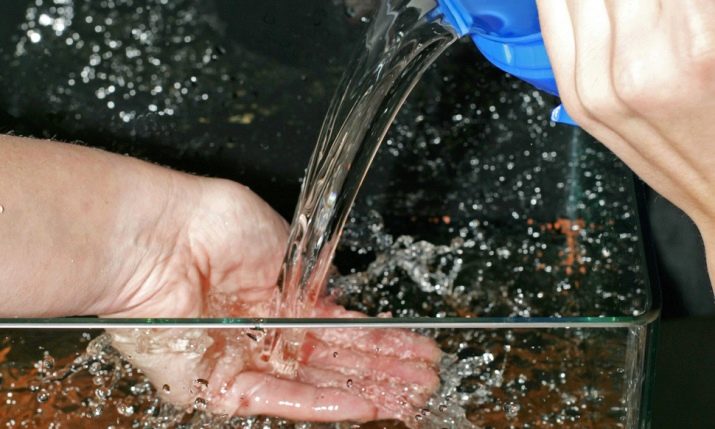
Full
Since there are two options for changing the water in an aquarium, you need to know when to use one or another method. For this it is worth evaluating:
- general condition of the aquarium;
- the level of filtration applied to the water;
- the time period in which the water is changed in the aquarium;
- use of chemical compounds.
If you update the aquatic environment weekly, then the optimal amount will be the replacement of 10% of the volume and no more, which will make it possible to remove excess organic compounds, to normalize the pH level. If this procedure is carried out twice a month, then the amount of replaceable moisture can be increased up to 20%, and in some cases up to 30%. During this period, the amount of chemicals increases significantly and begins to harm the fish. If there is a need to apply some kind of fertilizer, then it is recommended to change 30% of the water in order to remove excess substances that are no longer needed in the aquarium.
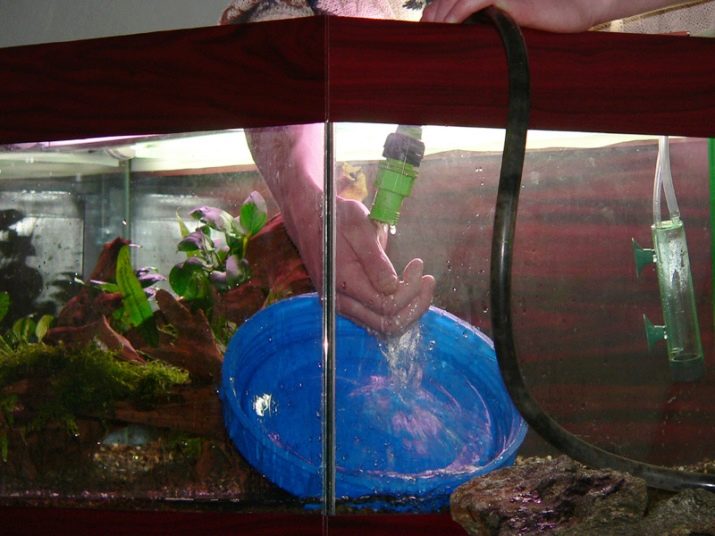
It is recommended to do partial replacement both in the case of a heavily contaminated aquarium, and during the introduction of planned medications. Replacing more than 50% of the aquatic environment is considered harmful to fish. A complete change involves emptying the container, and pouring completely new water, for which good reasons are needed, these are:
- active growth of algae, which turns into a real problem and is not eradicated in any other way;
- the presence of fungal mucus on the aquarium or decorative items inside it;
- soil contamination and the beginning of the acidification process;
- the appearance in the water of infections that affect plants and fish.
Using a complete water change procedure is very bad for the fish and can lead to their death, but even without it, the result will be the same.
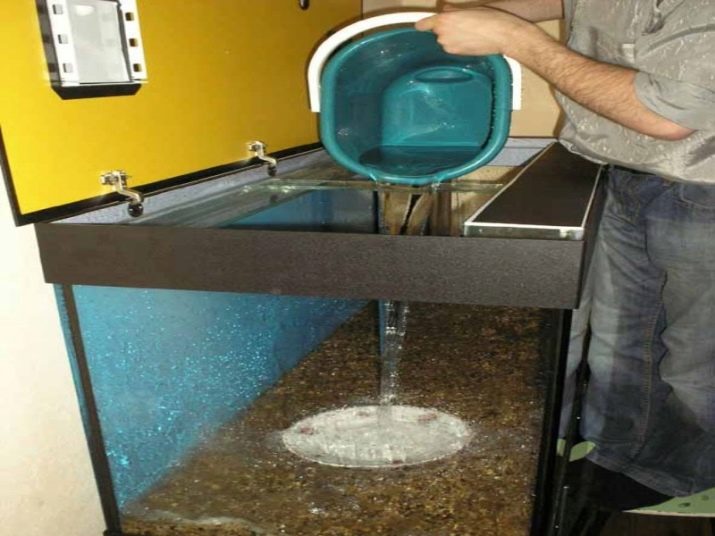
Fish that have already formed a certain ecosystem for themselves are deprived of it and are forced to adapt to new conditions, which may differ significantly from the previous ones. Plants also go through a certain stage of adaptation, which can result in a change in the color of their leaves, which will become lighter.
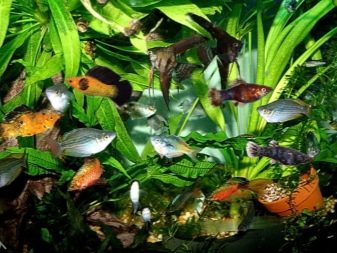
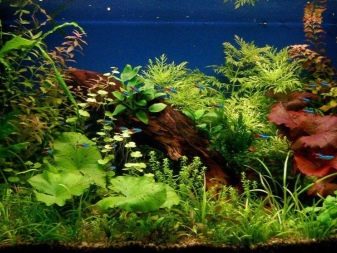
How often do you need to change?
The procedure for changing the aquatic environment in the aquarium can be carried out with different frequencies, which is interconnected with the age of the tank itself for the fish and the ecosystem that has been created in it. There are three ages of such an aqua system:
- young;
- mature;
- old.
In the case when the aquarium was purchased quite recently, and new fish are launched into it, fresh plants are planted, it is best not to change anything for several months, allowing a new ecosystem to form. Something can be changed in this case only as a last resort, if it is impossible without it.

As soon as the aqua system is formed, a small part of the water can be automatically changed no more than once a month. The permissible volume is considered to be 10-20% of the aqueous medium, which must first be settled. A daily procedure is considered undesirable, as it will interfere with the stabilization of the microclimate in the aquarium, however, carrying out such events too rarely will also have a bad effect on the health of fish and plants.
As soon as the time period of six months passes, the aqua system enters the mature stage, but it is taken care of in the same way. In the case when the vegetation and fish are doing well, the water is clean, the walls of the aquarium are not contaminated, it is better not to interfere, and from time to time skip liquid change events.
If the aquarium is already old, and the ecosystem is in a stable position for up to two years, then it is recommended to carry out rejuvenation, which consists in changing the mode of supplying clean water to the aquarium... The optimal schedule would be to carry out procedures twice a month, in addition, it becomes mandatory to clean the soil, and sometimes to extract and rinse it.
Such anti-aging actions should last for about two months, after which the care returns to the previous schedule, and the renewed ecosystem can function for a year or more.
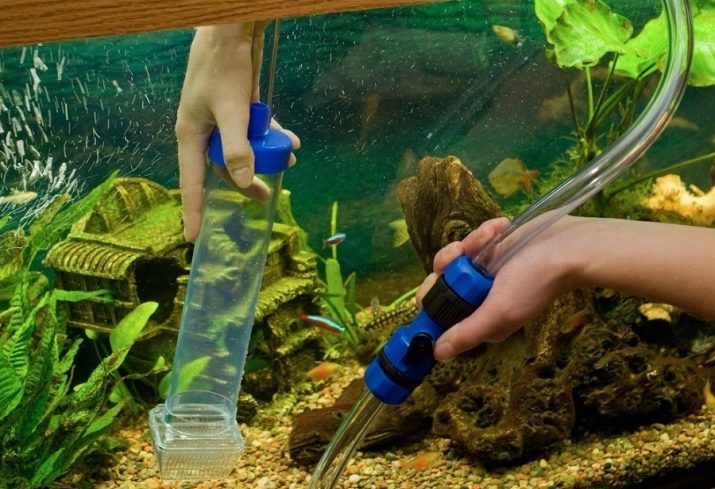
Water preparation
Only specially prepared water can be used for the aquarium. If you pour a simple liquid from the tap, it will harm the plants and the fish themselves due to the presence of a large amount of air and chlorine. Water of this quality can cause gas embolism, due to which air bubbles appear in the blood, blocking blood vessels, which leads to a slow opening of the gill covers, and soon the fish dies. This problem is due to the fact that the formula of the liquid is not at all H2O, but much more complex, which negatively affects the inhabitants of the aquarium.
To protect the living creatures in the aquarium from negative consequences, it is necessary to settle the water before using it. Thanks to such measures, it is possible to avoid oversaturation of water with oxygen and harmful chemical compounds.
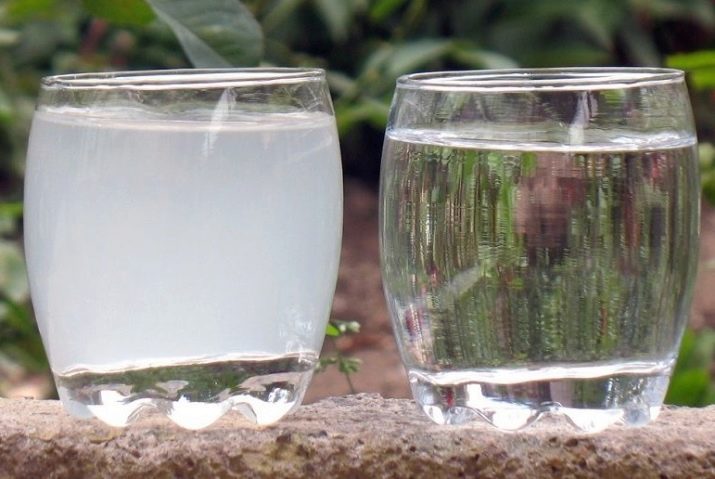
If there is a desire to use lake or river water, then it is necessary to heat it up to 80 degrees in order to eliminate all dangerous microorganisms. Using rainwater for an aquarium is considered wrong, as it contains many impurities, and without high-quality filtration, the liquid will only do harm.
Water settling is considered the most effective option for preparing material for filling an aquarium. The duration of the liquid preparation period will depend on several factors:
- the purity of the tap water;
- water quality;
- the presence or absence of chlorination.
Under the most favorable conditions, it is worth leaving the water to settle for one day, and in the most neglected state - for at least 2 weeks. All harmful substances descend and settle to the bottom, and the upper part is gently poured into the fish.
An important factor in the treatment of water for aquarium fish is considered to be the pH level, which should correspond to the range of 7-8, all other values are considered destructive.
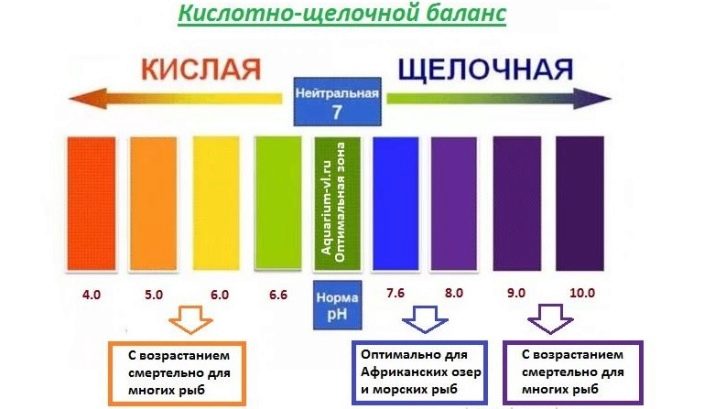
Step-by-step instruction
To make a water change in an aquarium with your own hands, you need to know the correct sequence and prepare everything you need. To work, you must have:
- prepared clean and soft water at room temperature;
- a clean container where fish or decorative items will be removed;
- bucket for catching fish;
- a hose for pumping water out of the aquarium;
- scraper for cleaning the walls of the aquarium from dirt.
The system for updating the aquatic environment in a large and small aquarium is similar, only the scale of the work and the frequency of their implementation differ. If the container is large, then it is possible not to change the water in it for a longer time, whereas with a small aquarium you will have to do this 1-2 times a week, renewing no more than one-fifth of the total volume of liquid.
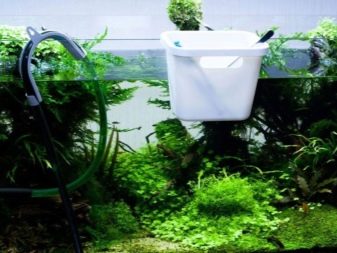

You need to change the water in the aquarium in a specific sequence.
- Remove all decorative items and equipment from the aquarium.
- A small water change can be carried out with the fish, for which the old liquid is carefully scooped out, after which a new one is poured in.
- If there is a need to replace a rather large part of the water, it is necessary to catch the fish and place them in the prepared water in a separate container.
- When the excess water has been drained, the walls of the aquarium should be thoroughly washed to remove all the dirt and plaque that clogs the aquarium.
- The soil should be cleaned or washed from fish and plant waste products. Plants and algae must be thinned out, old ones removed and existing ones trimmed to give a neat and effective appearance.
- The decorative elements are washed out in the water that has been drained from the aquarium. This is important in order to retain the desired microorganisms.
- Once everything is ready, you can gently pour in new water and start the fish into the aquarium. If most of the aquatic environment has changed, then it is worth giving several days to normalize the microclimate in the new environment, and only after that let the fish into it.
If there is a need to change the water, then you need to do this procedure correctly, choosing high-quality water, cleaning the aquarium, and also washing out all the decorative items that are in it.
A small product is less of a problem and can be handled with little effort compared to oversized aquariums. but the frequency of such procedures will be much higher, which is not to everyone's liking.
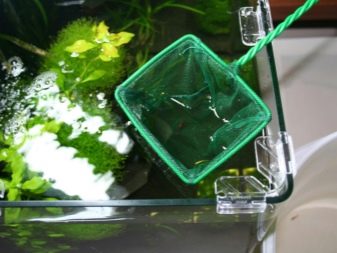
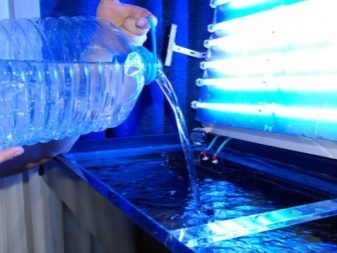
Recommendations
If there is a desire to have a beautiful aquarium with fish, but there is not much time for constant care of it, you can get out of the situation and plant a large number of plants that will become a natural filter and help keep the inside of the tank with fish clean, maximizing the period from one water change to another ... To ensure a comfortable habitat for fish, it is important to know the hardness of the water and the level of its acidity. It is extremely difficult to independently check such indicators, because it is worth purchasing a special litmus paper that will give all the necessary values.
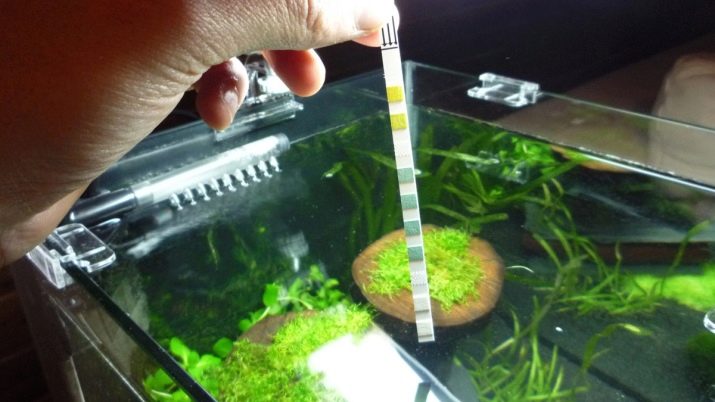
It is worth deciding on the frequency of the water change, so as not to overexpose the fish in dirty water, and not to injure them with too frequent changes, because both of these options will lead to negative consequences, and the fish population may die.
You should not rely only on your opinion and feelings in the process of caring for the fish and changing the moisture for them, since there are very clear rules that allow you to get a beautiful aquarium with healthy inhabitants without much hassle and worries.
For more information on how to change the water in your aquarium, see the next video.








